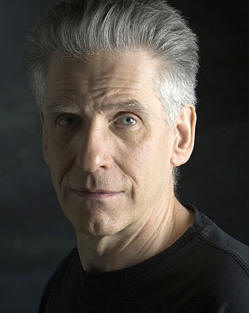 DAVID CRONENBERG
DAVID CRONENBERG
A DIRECTOR LOOKS AT VIOLENT AMERICA
by Brad Balfour
Copyright ©2005 PopEntertainment.com. All rights reserved.
Posted:
November
3, 2005.
Now transformed from a
horror genre master (Rabid, The Brood, Scanners, Videodrome) to a
full-blown, critically acclaimed and analyzed auteur, Toronto-based
director David Cronenberg finally has made A History of Violence Ė
the film that may be the Oscar-garnering capper of his career. With
Cronenberg having done films with exploding heads, weird parasites
entering various body parts, and babies growing in sacs on their mother's
stomach, this story of a simple small town cafe owner confronted with a
criminal act that makes him a hero and changes his life, is downright
restrained beyond belief. Yet the 62 year-old Cronenberg has crafted a
timely meditation on the nature and effect of violence on a man and his
family.
What did you really want this film to address?
The iconic American
mythology was very interesting to me. I haven't set a movie in America
since The Dead Zone. It's not like I have a message to the world.
When it came to the depiction of violence, it was where did the characters
learn their violence? And what was violence to those characters, but my
idea of what I think violence should be. Violence is innate in humans; we
are that strange creature that can form abstract concepts, so we can
conceive of non-violence. There are people who think that a world full of
peace would be boring and would lead to a loss of creativity. That's an
interesting, perverse argument that might some truth in it.
It's in this film.
The fact that the
audience finds the violence exhilarating and that the children find it
attractive, even though they are repelled by the consequences, shows the
conundrum we have with violence. So many people fear it, there's so much
money, energy, and government that are trying to avoid it at the same time
that we outfit armies to go and commit it on other people Ė itís very
paradoxical and endlessly fascinating, yet it's also very attractive which
brings out the animal part of ourselves. Even the human, intellectual part
of ourselves is also attracted to it. It's not easy to lament that we are
violent creatures because that is just too simplistic.
Even in the sex between Viggo Mortensen and Maria Bello?
That's right. People
experienced in sex and honesty will admit that there's a component of
violence in sexuality Ė whether it's subliminal or not. Radical feminists
have said that any form of sex is rape. I know that they are extreme, but
I know what they're saying and there's some truth in it. Even that which
can be considered tender and intimate is, in a sense, a spatial violation.
That's what makes human sexuality so complex and reflective of every
aspect of the human condition. That's why I tend to have sex scenes in my
movie; I am failing to really deliver the goods to myself and my audience
in terms of looking everywhere for what's really going on unless sexuality
is in some way being examined. Especially in this movie, where there's a
couple who have been married for 20 years and has two children and the
only sex scenes are between the couple. How could you really say you've
done your scenes-from-a-marriage routine if you haven't acknowledged their
sexuality in a very specific way.
Yet there's an optimism to this film.
The feeling is that, perhaps, for Edie (Bello),
the Tom/Joey (Mortenson) hybrid is the full guy. Perhaps the marriage
could even be a better marriage with the acknowledgment of that. Whether
she can live with that or not is a whole other thing. With the sex scene
on the stairs, there's an attraction-repulsion thing happening. That's
another reason why I felt I had to have that scene. Despite the difficulty
that people have with that scene, it is necessary to set up the
possibility of hope in the ending.
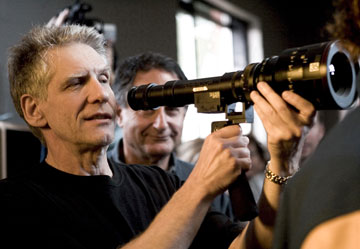 How
did you make your casting choices?
How
did you make your casting choices?
I gradually narrowed it
down. After all, the movie cost $32 million, which means I had to have an
actor of a certain stature for the studio to feel that they can sell the
movie. It's very straightforward. I didn't need a big star like Tom
Cruise, but I did need somebody who is recognizable and has fans already.
Very few movies can be successful with unknown actors. Even for a two
million dollar movie, the producers will want a recognizable name. That
automatically limits you to a certain number of people. Then there's the
age that the characters must be, within a certain range. And he has to be
somebody who can carry a movie as the leading man, but, for me, he has to
be more of a character actor. He has to disappear into his role as well as
be subtle, eccentric, charismatic, and real all at the same time. It's a
difficult thing to find. There's the subtle other thing that is beyond
articulation which is my sensibility in terms of actors. There are some
actors who I can admire in terms of their acting ability and stardom, but
no compulsion to work with them. I go for certain actors that are my kind
of actors.
What about an actress like Maria Bello?
The same goes for
actresses. Maria is a beautiful woman, but still not what somebody says is
the "ice princess" model of Hollywood
these days; she's real. That means that she bring subtlety, complexity,
and possibly the difficulty of her character. I want a real woman, but not
an icon.
You've never been afraid to show the ugliness of violence.
I don't know, I must be
fearless, it seems. For me the first fact of human existence is the human
body. I'm not an atheist, but for me to turn away from any aspect of the
human body to me is a philosophical betrayal. And there's a lot of art and
religion whose whole purpose is to turn away from the human body. I feel
in my art that my mandate is to not do that. So whether itís beautiful
things Ė the sexuality part, or the violent part or the gooey part Ė itís
just body fluids. It's when Elliott in Dead Ringer says, "Why are
there no beauty contests for the insides of bodies?" It's a thought that
disturbs me. How can we be disgusted by our own bodies? That really
doesn't make any human sense. It makes some animal sense but it doesn't
make human sense so I'm always discussing that in my movies and in this
movie in particular. I don't ever feel that I've been exploitive in a
crude, vulgar way, or just doing it to get attention. It's always got a
purpose which I can be very articulate about. In this movie, we've got an
audience that's definitely going to applaud these acts of violence and
they do because it's set up that these acts are justifiable and almost
heroic at times. But I'm saying, "Okay, if you can applaud that, can you
applaud this?" because this is the result of that gunshot in the head.
It's not nice. And even if the violence is justifiable, the consequences
of the violence are exactly the same. The body does not know what was the
morality of that act. So I'm asking the audience to see if they can
contain the whole experience of this violent act instead of just the
heroic/dramatic one. I'm saying "Here's the really nasty effects on these
nasty guys but still, the effects are very nasty." And that's the paradox
and conundrum.
You're a Canadian who's made this essay about violence in America and you choose not to adorn it with special effects and visual
dramatics; that makes this story so profound and so "Cronenberg..."
Yeah, it's a tendency I
have and I relate it somewhat weirdly to Samuel Beckett, and modernism.
Somehow I feel that to me, one of the ultimate challenges is to not adorn,
not to hide behind stuff. There are very easy things that you can do in
films, especially now, to disguise yourself and make things easy and
protect yourself. I'm as vulnerable as my actors, maybe more so when I
direct a movie. Maybe not in the same physical way, but very vulnerable
and itís very tempting to do stuff, to hide behind it. I try not to do it,
or get overly technique-y. If you can do it right, there's a raw
simplicity that's incredibly powerful because there's a certain truth
right there. If you blow it, there's nothing to hide behind. Itís obvious
when you've blown it. So that's why you get guys that do jittery camera
stuff when it's just a guy sitting in a room talking; they do stuff up
here and they've got cranes and whatever. I just sit there and say "Ok,
I've cast this guy for his face, for his voice, for his acting. I just
want you to see that. Let's just trust all that you've done and look at
this guy talking." I don't need to do fancy, silly stuff that has no
meaning or artistic purpose.
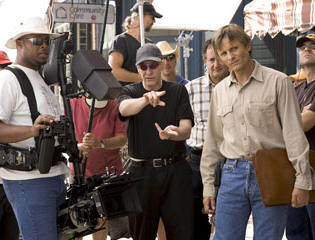 When
Tom/Joey leaves small town life, is he really changed?
When
Tom/Joey leaves small town life, is he really changed?
That's certainly the way
we played it. Imagine, he's suddenly forced out of the identity he had and
you have to decide how much of this you want to reveal to your viewers
obviously, or you could spoil the movie for them.
Don't worry.
[When he originally left
the East Coast], he could have chosen to be anything Ė to be a Joey in
Florida, or a Joey in the west coast. He could have gone to some other
country and been a small time gangster. But he chooses to be part of this
American mythology of itself, this kind of ideal guy in this ideal small
town with a family. Non-violent. Very sweet. Very gentle with his
children. And he genuinely is. He's been that for twenty years. So he's
been very successful at that. And that's not hiding. At that point he
really wanted to become somebody else. If he got hit by a bus before the
bad guys came to town, he would have been buried as Tom Stall, everybody
would have thought that's who he was and that's who he would have been.
So when the violence breaks out, was he reverting?
No. The way we were
playing it was that Joey was not actually a violent person. He didn't have
that incredible anger and rage. Because you would feel that if he had that
incredibly violent temper and anger and rage for example that it would
come out in those twenty years that he tried to be Tom. You know it would
have come out sooner. But in this case, Joey learned violence because Ė
being physically kind of athletic Ė he could be good at it, because he
grew up in the streets of Philly. His brother was a mobster, the union was
mobsters and to be successful and have some kind of life there, he had to
become part of that. He could do violence, so he did violence, but he
wasn't particularly innately a violent person. So it was just as he says,
when his brother says, "We're brothers, what did you think would happen?"
He replies, "I thought that business would come first." For him it was
business. And that was the approach to violence in the movie that I took,
which is rather an imposing concept of what violence should or shouldn't
be. I wasn't thinking about that... I'm thinking, "Okay in this movie
where does the violence come from?" It comes from these guys who learned
it on the streets and from the business. Its not sadistic pleasure, an
aesthetic thing, or a martial art with a philosophy in fighting, it's just
business. You do it. You get it over and get on to the next thing and make
as little fuss about it as possible. That's what it is to Joey, and
therefore itís very possible for it to disappear. Now it comes back only
because it's a tool he needs, that he has. It is like the gunslinger that
was the fastest gun in the west that put his guns away, you know? It has
American iconic reverberations and we were very conscious of that.
[Joey's] the guy who's reluctant to kill although he has a talent for
killing, but itís not something that gives him pleasure. That's really the
approach we took and itís realistic in the sense that it would make it
possible for him to become Tom and live that life for so long without
revealing something else.
When you show the sex scene after the shootings, the intoxicating effect
of the violence affects how they have sex with each other Ė as opposed to
before it was revealed.
If you see the movie a
second time, it becomes a different movie and only then can you really
appreciate Viggo's performance fully because we were conscious of making
two movies at once and it had to work both ways Ė for both viewings. But
once the violence cat is out of the bag itís up for grabs. For me the most
violent moment of the movie is when he slaps his son. That's a shocking
moment and you definitely get the feeling that it's the first time he ever
laid a hand on either of his kids violently. It depresses and shocks him
as well as shocking his son because the violence cat is out of the bag and
itís hard to put it back in. Once again it's a tool, but it's a tool that
has to be ready, the adrenaline has to be there, so and it comes out in
the sexuality as well.
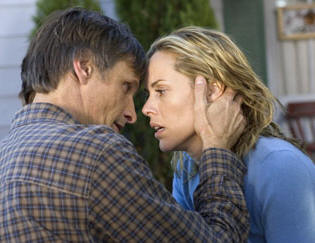 Your
films have a weird air to them because they're like American but not.
Your
films have a weird air to them because they're like American but not.
Many years ago, a
producer who just started talking to me about that said, "You know, for
Americans, your movies are really weird." Now this was a long time ago,
because the streets are like America,
but they're not. The people are like Americans but they're not. It's like
the pod people kind of thing. And he said that gave [my films] that spooky
edge for an American. I'm thinking, "Well that's us Canadians, you know,
we're the American pod people. We're like American people but we're not,
we're quite different." I've only really set a couple of movies, maybe
three in America. One was The Dead Zone; another one, Fast
Company had scenes that were set in America.
You've shot in America?
I have never shot a foot
of film in America.
You didn't shoot the exteriors of the town in America?
That was Millbrook,
Ontario.
You can't compare Toronto to any American city, but itís all American cities in a sense.
Sure, it is, and there
are certain essences of American cities that are totally not there. It's
because our histories are interlinked but they're quite different. You
know, we didn't have a Civil War, we didn't have a revolution, etc. We
sent the mounted police into the western territories first with guns. Then
the citizens came without guns. So there was never that sense of intense
individualism that you have in America. Where a man with a gun, he's the
law, we always have had in Canada, more intense understanding of the
social fabric where you have to negotiate and discuss and stuff like that.
Is the virus in
History of Violence the past or is it violence itself the virus?
Well, you see, I don't
think that way, you know, in the sense that you're bringing a concept, a
sort of critical and analytical concept to bear on this movie. I
absolutely don't mind that, some very interesting and enlightening things
can come out of that process. But that's not a creative process, that's an
analytical and critical process; I don't think of that, for instance when
I was making the movie that thought would never have been in my mind.
There were many thoughts in my mind but I don't think about my other
movies. I don't think about the place of this movie in the pantheon and
blah, blah. I really take each movie on its own and try to give it what it
needs individually without imposing something from the outside, including
what people have thought about my other movies. So you're going to have to
answer that question I'm sure.
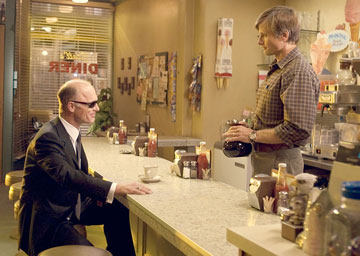 Reflecting
on your own life and on your own work, do you find that your movies are
like different chapters from the same book?
Reflecting
on your own life and on your own work, do you find that your movies are
like different chapters from the same book?
Yes, I don't deny
obviously that there is a connection. The thing is that I don't have to
force the connection, because you literally make one or two thousand
decisions a day as a director. There are decisions about everything from
clothes to colors, to walls, to locations to actors and what wins in
lighting and you'll know that nobody else would make those same decisions.
And so the movie will be enough of you, you don't have to force it. I
don't have to say I have to put this thumbprint on it so the people will
know itís my movie. Did I answer the question?
Well, how does this chapter in the book relate to your work?
But see, I don't have a
perspective on it because I've just made the movie. Itís my most recent
movie so I'm most involved with it and my other movies are the past and
I'm just not thinking of them. It's a legitimate metaphor that you're
using, that each movie is a kind of a chapter. I wouldn't have made this
movie the same way 10 years ago. I wouldn't have been the same person, so
it is revealing of something but I am the last person to be able to say
what that something is.
After the heaviness of Spider is it nice to kick some people in the face?
No, not at all. Although
I won't say that didn't have a reaction on Spider. But the reaction
was that I didn't make any money on Spider and I needed to do a
movie that I could make some money on. In the sense that I couldn't afford
to do a low budget independent film whose financing was constantly falling
apart and therefore we would all have to defer our salaries and not get
paid. I literally did not make any money for two years and I could not
afford to do that. So that was the reaction. On the other hand, Spider
was still a wonderful experience and frankly I think it's the other half
of this movie. I mean, it also is about identity and the construction of
it, and the possibility of it, and the consequences of it. In Spider
you have a man who does not have the will, the creative will for whatever
reason, to hold his identity together. He keeps disintegrating and falls
apart. But each movie has a family in it. Has a past that has a huge
impact on the present and its also, both movies are about identity. So I
think they would be pretty interesting on a double bill for a certain very
special audience.
Do you find it easier to work with an adapted screenplay?
It comes from laziness
and momentum, basically. Even Brian DePalma, who wrote his original
screenplays, took a while to finish writing them. You have to sit down for
maybe two years to write it. Maybe it's no good or maybe its okay but you
can't get it made. So, the pressure is on you to go with a project that a
producer has already been excited about so that you don't have to take
those two years off only to find that you haven't managed to produce
something that's worth making. When I did The Dead Zone, my first
adaptation, I found it exciting to get out of myself. You can bore
yourself with you. The idea that you will fuse with some other
interesting, different personality and then create some third thing that
neither one of you would have produced on your own is really interesting.
I did that with interesting people like Stephen King, William Burroughs,
J.G. Ballard, and now Josh Olson.
With A
History of Violence, has your filmmaking style changed?
I don't know if it
changed. I'm always experimenting, which comes from the nature of the
particular project. Each movie demands its own things, like a child. It
starts to become something else. As the doting parents, I feed it what it
needs so that it evolves into its own individuality. The movie tells me
what it wants, which could be different from what cinema should be or from
what my movies used to be; I can't think about all that stuff---I can only
think about feeding this demanding child.
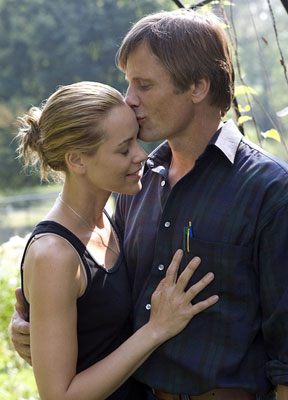 Do
you think
Spider and A History of Violence share some thematic elements?
Do
you think
Spider and A History of Violence share some thematic elements?
I only see that after
the fact. It's not like I thought of that when I started to make this
movie. It's only when I'm doing interviews and people are asking me to be
analytical about my films. The creative impulses are different from the
critical and analytical ones.
Why do people who make comedies tend to be angry and depressed and
people who make very violent movies tend to be nice and funny?
It seems to be true,
isn't it? I mean there's nothing scarier than a comedian. They're angry,
depressed, terrible people. Let's face it. It must be. I mean I guess itís
easy to say, but it seems to be inevitably true that there's a kind of
balance that's struck. If you're kind of perky and funny in your life then
you feel that you have to deal with the other stuff in your art and vice
versa, you know.
Are you excited about the buzz about this film Ė given that you're a
Canadian making such an American film?
I've been through this
before [laughs]. With Dead Ringers, I was told endlessly
that Jeremy Irons was a shoe-in for best actor at the very least, but, of
course, that didn't happen. So, I realized the game-playing that goes on.
Although, The Fly did win an Oscar for best special-effects and
makeup, so I have done the Oscar thing. But it's not a goal and it's not a
necessity.
What are you working on for the future?
There are a few projects
that are possible. One is an adaptation of
London Fields
Ė Martin Amis'
novel; I'm a huge Martin Amis fan. Another is called Maps to the Stars,
which is written by Bruce Wagner who is also an LA novelist and a close
friend. Robert Lantos will be producing that if that happens. There are
all things that are possible, but they are not at all for sure. They would
be in the independent film range of budget and financing.